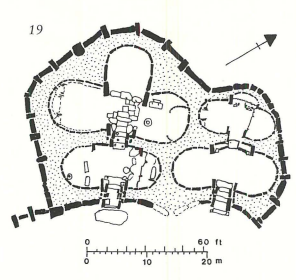
At this point most of Hancock’s schtick is pretty routine, so I’m reviewing two episodes at once. I’ll try to stick to just the main points. Feel free to ask questions in the comments below.
At the beginning of episode 3, Hancock mentions that it is possible to lose civilizations. Of course it is. We have archaeological evidence of civilizations that were lost either because new civilizations appeared to take their place, because the original civilization moved on, or because a natural disaster removed them. Civilizations leave behind material things.
Much of this third episode of Ancient Apocalypse centers around Malta and it’s Temple Period architecture. The conclusion Hancock starts with is that there was a lost, advanced civilization–the same one he never seems to define–that arrived during the Pleistocene along with Neanderthals and built the temples after their arrival 12,000 to 14,000 years ago, or maybe he means over 42,000 years ago when there were still some Neanderthals.
To begin framing the existence of his “lost advanced civilization,” Hancock needs to move the dates of the temples on Malta to a more convenient timeline. The 3600 BCE to 2500 BCE construction range settled on by archaeologists is inconvenient to him. And he cannot fathom how the ostensibly stupid and incapable indigenous people might have moved stones and figured out how to build something monumental. Hancock says:
“Think about it: Could those farmers, who archaeologists tell us never built anything bigger than a shack, really have achieved all this?”
If this isn’t a racist comment, it’s one that is completely bigoted. And I really hope it’s unintentional.
To help him with the problem of chronology for the temples, Hancock simply states, “there are no written sources telling us when Ggantija was built, and no reliable carbon dates.”
This might be partially true. Maltese wasn’t written until the 19th century, so of course they didn’t write down temple construction details. However, dating of the temples is available. And reliable.
Optically Stimulated Luminescence (OSL) dates exist for much or all of the Temple Period architecture. OSL works by determining when sediment particles like feldspar or quartz were last exposed to sufficient sunlight or heat. Malone et al (2020) describe OSL dates for Ggantija that produced dates between 3600-3080 BCE for lower stratigraphic levels and 3200-2760 for upper levels.
Accelerator Mass Spectrometry (AMS) Dating, which is a form of radiocarbon dating, of plant and animal remains from the Ggantija temple produced results of 3600-3300 BCE (Trump 2002) and 3650-3050 BCE (Malone 2009). These radio carbon dates are relatively consistent with each other and the OSL dates, making them fairly reliable.
Was Hancock ignorant or lying about the lack of reliable radiocarbon dates? I suspect he’s just ignorant since he seems only to see that data which are agreeable with his pre-conceived conclusions.
So what else does Hancock say about the Maltese Temple Period?
He says the temples show no indication of gradual development over time, implying the Maltese people didn’t have time to figure out how to make them. Along this sentiment, he states that there is more architecture than manpower across the two islands of Malta. And he claims they all line up with Sirius.

OSL and AMS, though there is some room for revision with Mgarr
and Saflieni phases. But not on a Hancock imagined scale. From
Malone, et al, 2020.
The temples, assuming they are indeed “temples,” actually do show an evolution over time. They get bigger, for one thing. Particularly at Santa Verna where there are even hiatus breaks noted in the archaeological record. And radiometric dating (OSL, radiocarbon, AMS, and thermoluminesence) show varied periods of temple construction between both Gozo and Malta islands.
I’m sure Hancock would still point out that there aren’t examples of smaller, simpler constructions on the islands, rather it was as if they just new how to construct monumental examples right away. I would answer that just because we don’t see their early attempts and failures in the archaeological record, doesn’t mean they didn’t happen. Early monumental architecture could easily have been dismantled, demolished, or destroyed either by natural or man made forces.
If these temples are built on geographically important locations, as many monumental constructions in the world are, then their earliest versions might be right in front of us: palimpsests of architecture. The construction ranges for each of these temples is measured in hundreds and thousands of years. That same human intelligence that allowed for a Moon landing just a little over 60 years after the Wright Brothers took flight existed in the Neolithic and the Temple Period of Malta.
Are we to take Sirius Seriously?
Of course, Hancock’s Sirius alignments could have occurred at times he suggests, but there are a couple of problems he doesn’t consider, at least not out loud, on his television show.
First, this seems to be a good example of the Sharpshooter Fallacy to me as Hancock is literally painting a bullseye on the data. This is the guy that complains at the beginning of the show that he get’s accused of cherry picking data, and here he is with his hand in the jar of cherries. I’m sure I could mix in a few more metaphors, but just understand, if you create a fixed line on the earth, then keep spinning the night sky, eventually you will see patterns and spurious alignments
Second, Hancock ignores other potential star alignments. Crux, also known as the Southern Cross, actually shows up in the southern sky, generally lined up with most of the temple entrances, and would have been useful to those sailing between Sicily and Malta since it would take more than a day.
Third, there is good, reliable OSL and AMS radiocarbon dating for the temples and their construction periods. These data refute the majority of the Sirius alignments.

Crux; possibly with the winter solstice; possibly
just to let daylight in or keep the wind out
Fourth, Hancock’s celestial alignment assumptions don’t consider significance versus intentionality. Robert Barratt explains it best:
Significance is obtained statistically when the likelihood of an event occurring randomly is extremely low. Intentionality generally refers to the consciousness of human action. The alignment of temples towards cosmological events could be an intentional decision by the temple builders, or the orientations may have been dictated by practical considerations, such as lighting or wind resistance. In the latter case the temples are significantly oriented towards cosmological events, but the alignments are not intentional and hence have no archaeological value.
Barratt, Robert (2022, p. 3)
In other words, the temple builders might simply have been orienting to take advantage of daylight or to avoid the wind. Resulting star alignments would, therefore, be accidental and not the original intention.
On the Bimini Road Again
In the Fourth episode of this sensationalist nonsense Netflix calls a docuseries, Graham Hancock takes his Schtick to the Bahamas, specifically the Bimini Road.
I didn’t anticipate spending a lot of time on this since the “Bimini Road” claims are so well debunked and old-hat, and the science is so well established that what is being observed is limestone beach rock dating to about 2,300-3,500 years before the present (BP).
These dates were obtained back in the 1970s and 1980s by Gifford, Bell, and Calvert and involved a variety of core samples from the beach rocks themselves.
The geologic processes that created the beach rock are well understood and the only real characteristic of the stone slabs that Hancock features that is indicative of human manufacture is their apparent rectangular shape. And even this is nonsense to anyone that spends enough time outdoors or perhaps took the time to do a little research on geologic beach rock. Orthogonal jointing and fracturing of limestone is not uncommon.
Moreover, McKusick and Shinn (1980) found that the stratigraphy in their cores was consistent from one slab to the next. Of 17 oriented cores, the slope, particle size, and dip and strike directions of the sediment bedding was consistent from one core to the next. These cores were from 17 different slabs.
This is not something one would expect from a man-made feature of stones brought from a quarry, yet it is precisely what one might expect from a geological feature of sedimentary rock in situ.
Pseudoarchaeology or Pseudojournalism?
This episode demonstrated several of Hancock’s pseudoscientific and, pseudojournalistic tendencies.
Hancock will always seek the approval of professionals. If he can get a nod and a wink from an archaeologist, he’ll take it. When he cannot, he’ll find another professional that isn’t really in their wheelhouse, and get his acknowledgement.
Did you notice what the geologist on his boat said about the geologic feature 5 meters below the surface that they dived on? No? Let me tell you why: he didn’t have a geologist on board. He did, however, have a marine biologist.
Journalistic integrity demands that a journalist check his facts and that reporting is made as reliable as possible. Somewhere in these two expectations, one might expect that a relative professional be consulted when the journalist is investigating a controversial hypothesis.
One might expect that corrections are published when the journalist is demonstrated to report things in error.
Graham Hancock denies the he is any sort of scientist or archaeologist at the beginning of each episode, insisting that he’s a journalist investigating what he sees as a hidden truth. His books have been consistently shown to contain false, unscientific, and paranormal claims, yet he has never once issued a correction. No revised editions that I’m aware of (with exception to Supernatural, which seems to have at least one strange version). I do believe he was heavily invested in Mars as the origins of his lost super-race of people.
Now it appears he’s back to Atlantis.
This episode also includes a long section on the Piri Reis map. I find that map interesting for reasons different than Hancock obviously. I previously wrote about it here if you’re interested.
References and Further Reading
Barratt, Robert P. (2022). The Crux of Astronomical Alignment in Neolithic Malta: Using 3D Simulation to Produce New Data. Digital Applications in Archaeology and Cultural Heritage, 26, e00229.
Calvert, P.M., D.S. Introne, J.J. Stipp (1979). University of Miami radiocarbon dates XIV. Radiocarbon, 21(1), 107-112.
Gifford, John A. (1973), The Bimini ‘cyclopean complex. International Journal of Nautical Archaeology and Underwater Exploration, 2(1), 189.
Gifford, John A., and Mahlon M. Ball. (1980) Investigation of submerged beachrock deposits off Bimini. National Geographic Society Research Reports, 12, 21–38.
Malone, Caroline, Reuben Grima, Rowan McLaughlin, Eóin W. Parkinson, Simon Stoddart & Nicholas Vella, Eds. (2020). Temple places Excavating cultural sustainability in prehistoric Malta. McDonald Institute for Archaeological Research, Cambridge, UK.
McKusick, Marshall, and Eugene A. Shinn (1980). Bahamian Atlantis reconsidered. Nature, 87(5777), 11 – 12.
Trump, D.H. (2002). Malta: Prehistory and Temples. Santa Venera: Midsea Books.
I admire your fortitude, I can’t take 10 minutes of this kind of crap.
The gentleman doth protest too much, methinks 🙂